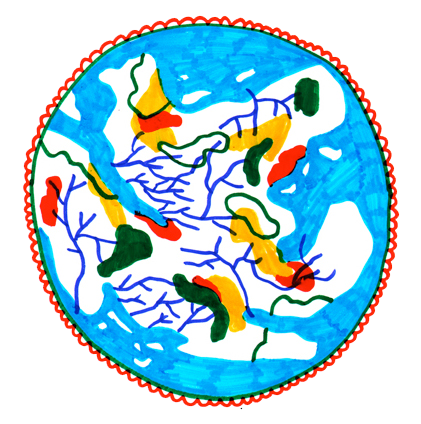The light show is inspired by the statue “The Man of the Flag” by Cor Hund, which commemorates the fallen soldiers and victims of World War II. This statue depicts a man holding flag, but it can also be interpreted as a man with an unfolded wing. Additionally, during World War II, the Dutch people experienced the “Hunger Winter.” Those who survived mostly ate edible wild plants.
This made me think about the idea of hope, renewal, and adaptation, especially after what happened on the battlefields at the end of the war when the soil were destroyed and polluted,
and it seemed irreversible. Some plants, known as “Obsidional plants,” have the ability to absorb polluted substances and repair the soil. These plants appear after the passage of an army due to the environmental consequences of war or the plants that soldiers bring with them voluntarily or involuntarily. Poppies and corn owers are beautiful examples of plants that appear massively after a war on a battlefield.
In this show, I want to create a gentle choreography based on these plants that accompanied humanity during these dark times. To structure the choreography, I am inspired by an excerpt from the beautiful poem “Mei” by Herman Gorter, which evokes springtime and the death of a poppy.
https://royallightfestival.nl/
------------
May
Song III
Zóó als die bloem van zomerrood, papaver,
Rimpelt zijn rood, verwelkend en zijn staaf er,
Zijn teeren stengel langzaam buigt omlaag
Zoo boog ook Mei langzaam haar hoofd omlaag -
En bleek en bleeker werden hare wangen,
En auw en auwer werd ook het verlangen
Dat in de oogen brandt der sterveling.
Al verder en al verder week de kring,
De wollige band van vuur, zooals de ruiters
Die uitrijden uiteen en op de muiters
Een aanval doen: ze maken’t heel ver stil.
En in zich voelde zij het laatste: wil,
Den allerlaatsten wil der stervenden,
Den wil tot doodzijn die het zwervende
Menschengeslacht doet stilstaan en hen drijft
Van zelve naar den grond waar’t lichaam blijft.
Ze duizelde en in die duizeling
Werd ze zoo licht, een veer die uit den zwing
Der duive valt; ze daalde en viel niet:
Zoo valt een riethalm over in den vliet.
Zóó als een kind dat in het leven was,
Zóó als een bloem van zomerrood in ‘t gras,
Roode papaver die nu neder ligt,
Zoo lag ze en der zonne laatste licht
Scheen op haar, maakte haar een weinig rood
En goud voor‘t laatst en ging toen met haar dood.
Herman Gorter (1864-1927)
---------
Mai
Chant III
Comme le coquelicot d’un rouge éclatant
Qui se ride, se flétrit, et dont la tige,
Fragile, s’incline lentement vers le sol -
Ainsi Mai courbait la tête
Et ses joues pâlissaient,
Et l’étincelle qui brille dans les yeux
Des mortels faiblissait.
Son auréole, doux cercle de feu,
S’éloignait d’elle, comme les
Cavaliers se dispersant pour
Attaquer les insurgés: autour d’eux, le silence se fait.
Et en elle montait une dernière volonté,
La toute dernière volonté des mourants,
La volonté de mourir qui fige
L’humanité errante et l’incline vers le sol
Pour que le corps puisse reposer.
La tête lui tourna et dans ce vertige
Elle devint si légère, une plume échappée au pigeon
en vol :
Elle planait sans tomber
Comme un brin de paille flottant dans un ruisseau.
Comme une enfant qui fut pleine de vie,
Comme une fleur éclatante dans l’herbe,
Un coquelicot rouge maintenant fauché,
Ainsi gisait-elle et le dernier rayon du soleil
L’éclaira, la nimbant pour la dernière fois
De rose et de doré - puis mourut avec elle.
Herman Gorter (1864-1927)





